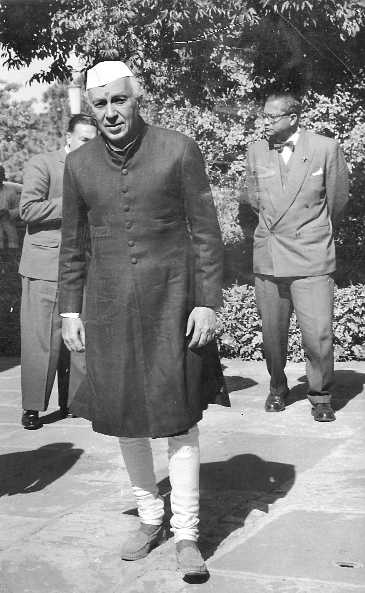
In Footsteps of Legends: The book says that Pt Jawaharlal Nehru, like Kautilya, was a realist and used Kautilyan thought in his political work as prime minister
Ashok Vohra
Many Orientalists, including many Indian philosophers, mistakenly believe that Indian philosophy is primarily spiritual and other worldly with hardly any space for reflection on the worldly matters. It has no place for social and political thinking. They think that Machiavelli's The Prince published in c. 1513 is the first treatise on politics. The term Machiavellian for them is associated with unscrupulous politicians, treachery and cunning.
Kautilya's Arthashastra was written between second to third century BC. It was lost for centuries and rediscovered in 1904. However, the text was not given the prominence it deserved and Kautilya was marginalised for decades by western and Indian political thinkers. The term 'Arthashastra' means 'Textbook of Statecraft'. It analyses prevalent political and strategic issues and inter alia arrives at the principles of governance, public administration, economics, law, foreign policy and diplomacy, military affairs and intelligence.
A few published studies on Kautilya were only expository. These descriptive texts lauded Kautilya for his deep understanding of human nature and psyche and condemned him for his ruthlessness and trickery. The authors of these sporadic works did not make any attempt to study the influence of Kautilya's theories on the political leaders who shaped modern India, or to work out the relevance of Kautilya in contemporary India and world. The present work successfully fills that lacuna. Its findings are not based on theoretical research, but on "the systematic analysis of conversations with a select group of 34 scholars, statesmen, political leaders and civil servants". So, it is a synthesis of 'hybridisation' of the ancient wisdom with the modern knowledge.
The book is divided into five sections. The first part, comprising 13 chapters, interprets the basic conceptual features and characteristics, and the underlying epistemology and methodology, argumentation and representation adopted by Kautilya in his Arhashastra. The authors, through a meticulous analysis of the core concepts of Kautilya's saptanga — the seven state factors, shadgunya — the six methods of foreign policy, and upayas — the basic principles of politics, give the reader an overall gestalt of the Arthashastra. Their comparison of Kautilya's theories with those of the leading western political philosophers makes the book very informative.
After analysing the Kautilya's notion of 'ideal state' in the nine chapters of the second section, the book elucidates Kautilya's influence on the ‘structure of governance in post-colonial India’. In the main, the authors have analysed the writings of Nehru. Nehru and Kautilya is the key chapter of this section. They have concluded that Nehru, like Kautilya, was a realist and that he ‘used (Kautilyan thought) in his political work as prime minister’. Refuting the charge of being an idealist, Nehru, reflecting on the question, “What exactly is idealism?” says, “Surely it (is) not something so insubstantial as to elude one's grasp. Idealism is the realism of tomorrow. It is the capacity to know what is good for the day after tomorrow or for the next year and to fashion yourself accordingly”. This in essence is Kautilyan realism.
The authors have mentioned in passing, without any substantial discussion and proof, that Gandhi and Patel were also Kautilyan in their political approach. Someone's saying that ‘an individual possessed the political acumen of Chanakya’ or ‘the astute statesmanship of Chanakya’ does not mean that he is Kautilyan. After an analysis of the available literature in the Kautilyan discourse, the authors have shown that world over there is increasing interest in the Arthashastra, and lament that it continues to be marginalised, even absent, in the curriculum of Indian universities.
The objective of the eight chapters, constituting part three, is to examine the impact of the Arthashastra on modern India and its politics. The authors have done so by analysing the thoughts and works of post-colonial India's opinion leaders like Gandhi, Nehru, and Patel et al. They have argued that post-colonial Indian policies and institutions are a hybrid of 're-use', rather than replacement, of the legacy of the past and the contemporary western political and social theories. The authors rightly assert that "Symbolic presence of the past constitutes a link of modernity with collective memory".
Part four, comprising four chapters, deals with the enigma how could democracy be successful in India — a society steeped in social hierarchy, poverty, deep ethnic cleavages, deep-rooted religious fragmented population, widespread illiteracy, subsistence agriculture and low incomes. The authors claim that the success of democracy in India can be traced to Kautilyan doctrine of orderly rule and the role of consent, as well as recognition of regional diversity.
In the concluding part five, the authors take up the factors that contribute to the emergence of interest not only in India but the world over in the strategic community and academia, in political and media contexts, in Kautilyan discourse. The emergence of realpolitik, that is, politics based on pragmatism or practicality rather than on ethical or theoretical considerations is the raison d'être
The book is a novel contribution in understanding the relevance of Kautilya in the contemporary world. Its fresh insights are presented in a lucid and jargon-free language. The book is of interest not only to politicians, Kautilyan scholars but also general readers.



























